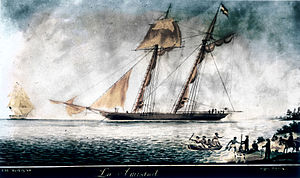 La Amistad off Culloden Point, Long Island, New York on August 26, 1839
(contemporary painting, artist unknown) | |
| Name | La Amistad |
| Owner | Ramón Ferrer |
| Acquired | Pre-June 1839 |
| Name | Ion |
| Owner | Captain George Hawford, Newport, Rhode Island |
| Acquired | October 1840 |
| Acquired | 1844 |
| General characteristics | |
| Length | 120 ft (37 m) |
| Sail plan | Schooner |
La Amistad (pronounced [la a.misˈtað]; Spanish for Friendship) was a 19th-century two-masted schooner owned by a Spaniard living in Cuba. It became renowned in July 1839 for a slave revolt by Mende captives who had been captured and sold to European slave traders and illegally transported by a Portuguese ship from West Africa to Cuba, in violation of European treaties against the Atlantic slave trade. Spanish plantation owners Don José Ruiz and Don Pedro Montes bought 53 captives in Havana, Cuba, including four children, and were transporting them on the ship to their plantations near Puerto Príncipe (modern Camagüey, Cuba).[1] The revolt began after the schooner's cook jokingly told the slaves that they were to be "killed, salted, and cooked." Sengbe Pieh (also known as Joseph Cinqué) unshackled himself and the others on the third day and started the revolt.[2] They took control of the ship, killing the captain and the cook. Two Africans were also killed in the melee.
Pieh ordered Ruiz and Montes to sail to Africa. Instead, they sailed north up the east coast of the United States, sure that the ship would be intercepted and the Africans returned to Cuba as slaves. The revenue cutter Washington seized La Amistad off Montauk Point on Long Island, New York. Pieh and his group escaped the ship but were caught offshore by citizens. They were incarcerated in New Haven, Connecticut on charges of murder and piracy. The man who captured Pieh and his group claimed them as property. La Amistad was towed to New London, Connecticut, and those remaining onboard were arrested. None of the 43 survivors on the ship spoke English, so they could not explain what had taken place. Eventually, language professor Josiah Gibbs found James Covey to act as interpreter, and they learned of the abduction.
Two lawsuits were filed. The first case was brought by the Washington ship officers over salvage property claims, and the second case charged the Spanish with enslaving Africans. Spain requested President Martin Van Buren to return the African captives to Cuba under international treaty.
Because of issues of ownership and jurisdiction, the case gained international attention as United States v. The Amistad (1841). The case was finally decided by the Supreme Court of the United States in favor of the Mende people, restoring their freedom. It became a symbol in the United States in the movement to abolish slavery.
- ^ "Teaching With Documents:The Amistad Case". National Archives and Records Administration. Retrieved March 14, 2013.
- ^ Purdy, Elizabeth. Encyclopedia of African American History, 1619–1895: From the Colonial Period to the Age of Frederick Douglass. Oxford African American Studies Center. pp. Amistad.